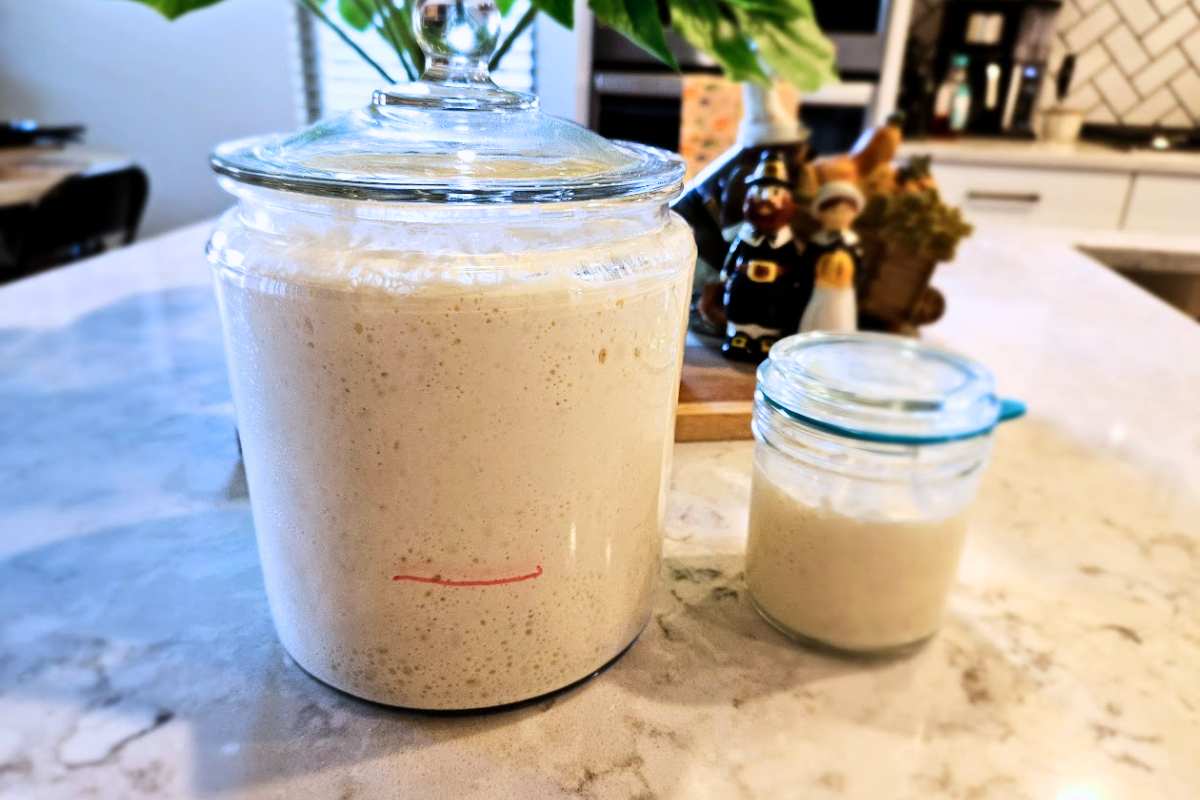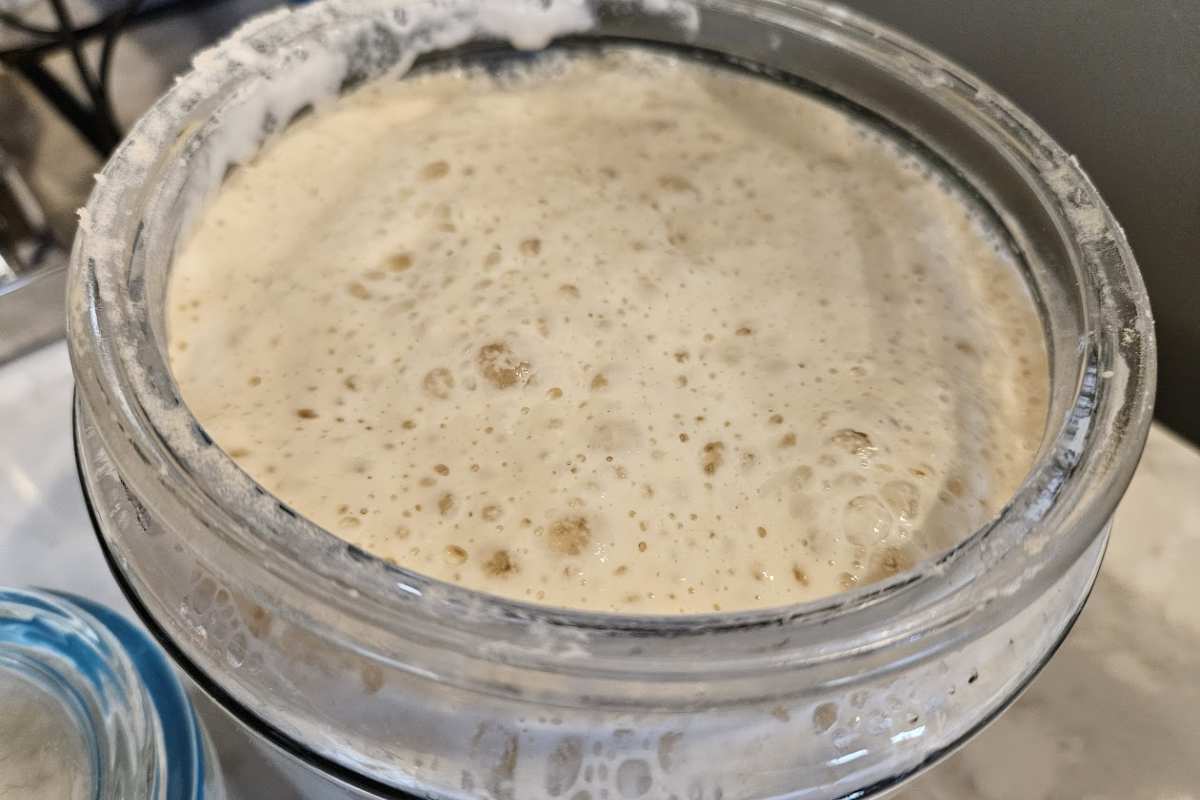
Sourdough starter, levain, chef, lievito madre, la masa madre, mother dough, mum—these terms can be quite confusing. What do they mean, and when should you use each? This post will delve into two essential components of sourdough baking: the sourdough starter and levain. Let’s explore their definitions and differences.

What is a Sourdough Starter?
A sourdough starter is a mix of wild yeast and bacteria that helps your bread rise. It’s made by combining equal parts of flour and water and allowing it to ferment over several days, usually 7-14 days. During this time, the wild yeast and bacteria present in the environment will naturally populate the mixture, creating a bubbly culture.
You can keep your starter alive indefinitely if you feed it regularly with more flour and water.
You’ll never use up your entire starter in one bake; instead, you take a small portion to mix into your dough while keeping some to maintain the culture. If you don’t use part of your starter in a dough, you can create a small off-shoot called a levain (leaven).
What is a Levain?
A levain, also referred to as leaven, is made from your sourdough starter. It combines fresh flour, water, and a bit of ripe starter. You use the levain entirely in one batch of dough, and then you bake it. The levain has a shorter life than the starter, so it’s best to use it soon after it reaches its peak activity.

Why Use a Levain?
You might wonder why to make a levain instead of just using your starter. Here are two main reasons:
- Scaling Up: A levain lets you create more preferment if your recipe requires it. This is especially useful for larger recipes.
- Flavor Adjustment: A levain allows you to change the flavor of your bread. For example, using whole grain flour in your levain can make the bread taste more sour, while using white flour results in a milder flavor.
What If I Forget to Make My Levain?
If you forget to make your levain, you can use your ripe sourdough starter instead! It may not give you the exact flavor you want, but it’s still better than not baking. You can also quickly make a levain by mixing equal parts of flour, water, and ripe starter, which will be ready in about 3-4 hours.
Do I Have to Make a Levain?
Some bakers choose to create large batches of their sourdough starter to use directly in their bread recipes. While this approach can work, it is generally recommended to maintain a smaller starter primarily for feeding. This ensures that your starter remains strong and active, allowing you to create a flavorful levain when needed.
Using a dedicated starter for feeding means you can keep it at peak freshness, which is crucial for the fermentation process. When you’re ready to bake, you can take a portion of this well-fed starter to bulk up and create a levain. This method not only helps maintain the quality of your starter but also allows you to control the flavor and texture of your bread by adjusting the leavening process.
Ultimately, the best approach is the one that works for you. Some bakers find success with a large batch of starter, while others prefer to create a levain for each bake. Experiment with both methods to see which suits your baking style and desired results!
Jake’s Sourdough Feeding Routine
To keep my starter healthy and active, I follow this feeding routine:
- 8:00 PM: Start with 3 grams of my existing starter.
- Feeding: Add 30 grams of white flour and 30 grams of spring water.
- Fermentation: Let the mixture sit at room temperature overnight.
After about 10-12 hours, my starter will be bubbly and ready to use.
Preparing Your Levain
After feeding your starter, you can prepare your levain. To determine how much levain you’ll need, follow these steps:
1. Calculate the Total Active Starter Needed
First, add up all the active starter required in the recipes you plan to make that day. For example, if your recipes call for a total of 250 grams of active starter, you’ll use this number in your calculations.
2. Determine Your Feeding Ratio
If you are using a feeding ratio of 1:10:10 (meaning 1 part starter, 10 parts flour, and 10 parts water), simply add the parts together:
1 + 10 + 10 = 21 (total parts).
If you were to use a ratio of 1:5:5, then the total would be 11 (1+5+5 = 11)
3. Find the Amount of Starter Needed to Create the Levain
To find out how much starter you need to create the levain, divide the total active starter required by the total parts:
250 grams (starter needed) ÷ 21 (total parts) = approximately 11.9 grams.
Always round up, so you’ll need 12 grams of your starter.
4. Calculate the Amount of Ingredients for the Levain
Now, use the amount of starter to determine how much flour and water to add based on your feeding ratio. For a 1:10:10 ratio, you will need:
- 12 grams of your starter
- 120 grams of flour (12 grams x 10)
- 120 grams of water (12 grams x 10)
Mix these ingredients together to create your levain. Then allow the levain to peak.
Remember, you can use any feeding ratio. The ratio you choose will depend on when you need your levain to be ready.
